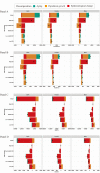Epidemiological analysis reveals a surge in inflammatory bowel disease among children and adolescents: A global, regional, and national perspective from 1990 to 2019 - insights from the China study
- PMID: 38037705
- PMCID: PMC10690112
- DOI: 10.7189/jogh.13.04174
Epidemiological analysis reveals a surge in inflammatory bowel disease among children and adolescents: A global, regional, and national perspective from 1990 to 2019 - insights from the China study
Abstract
Background: The burden of inflammatory bowel disease (IBD) among children and adolescents is rising globally, with substantial variation in levels and trends of disease in different countries and regions, while data on the burden and trends were sparse in children and adolescents. We aimed to assess the trends and geographical differences in children and adolescents aged zero to 19 in 204 countries and territories over the past 30 years.
Methods: Data on IBD among children and adolescents was collected from the Global Burden of Disease (GBD) 2019 database from 1990 to 2019. We used the GBD data and methodologies to describe the change in the burden of IBD among children and adolescents involving prevalence, incidence, disability-adjusted life years (DALYs), and mortality.
Results: Globally, the IBD prevalence cases increased between 1990 and 2019. Annual percentage changes (AAPC) = 0.15; 95% confidence interval (CI) = 0.11-0.19, and incidence cases of IBD increased from 20 897.4 (95% CI = 17 008.6-25 520.2 in 1990 to 25 658.6 (95% CI = 21 268.5-31 075.6) in 2019, representing a 22.78% increase, DALYs cases decreased between 1990 and 2019 (AAPC = -3.02; 95% CI = -3.15 to -2.89), and mortality cases of IBD decreased from 2756.5 (95% CI = 1162.6-4484.9) in 1990 to 1208.0 (95% CI = 802.4-1651.4) in 2019, representing a 56.17% decrease. Decomposition analysis showed that IBD prevalence and incidence increased significantly, and a trend exhibited a decrease in underlying age and population-adjusted IBD DALYs and mortality rates. Correlation analysis showed that countries with high health care quality and access (HAQ) had relatively higher IBD age-standardised prevalence rate (ASPR) and age-standardised incidence rate (ASIR), but lower age-standardised DALYs rate (ASDR) and age-standardised mortality rate (ASMR).
Conclusions: Global prevalence and incidence rate of IBD among children and adolescents have been increasing from 1990 to 2019, while the DALYs and mortality have been decreasing. Rising prevalence and rising incidence in areas with historically low rates will have crucial health and economic implications.
Copyright © 2023 by the Journal of Global Health. All rights reserved.
Conflict of interest statement
Disclosure of interests: The authors completed the ICMJE Disclosure of Interest Form (available upon request from the corresponding author) and disclose no relevant interests.
Figures




References
MeSH terms
LinkOut - more resources
Full Text Sources
Miscellaneous
